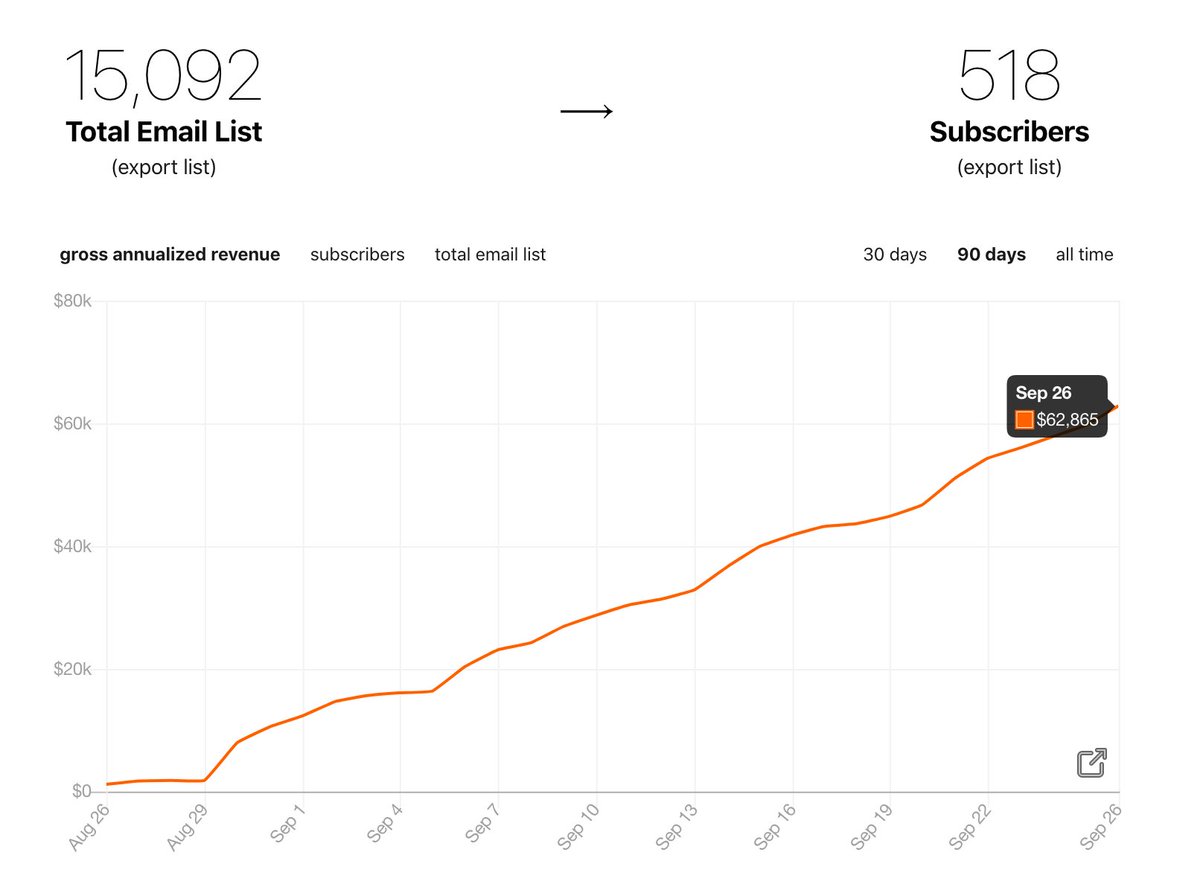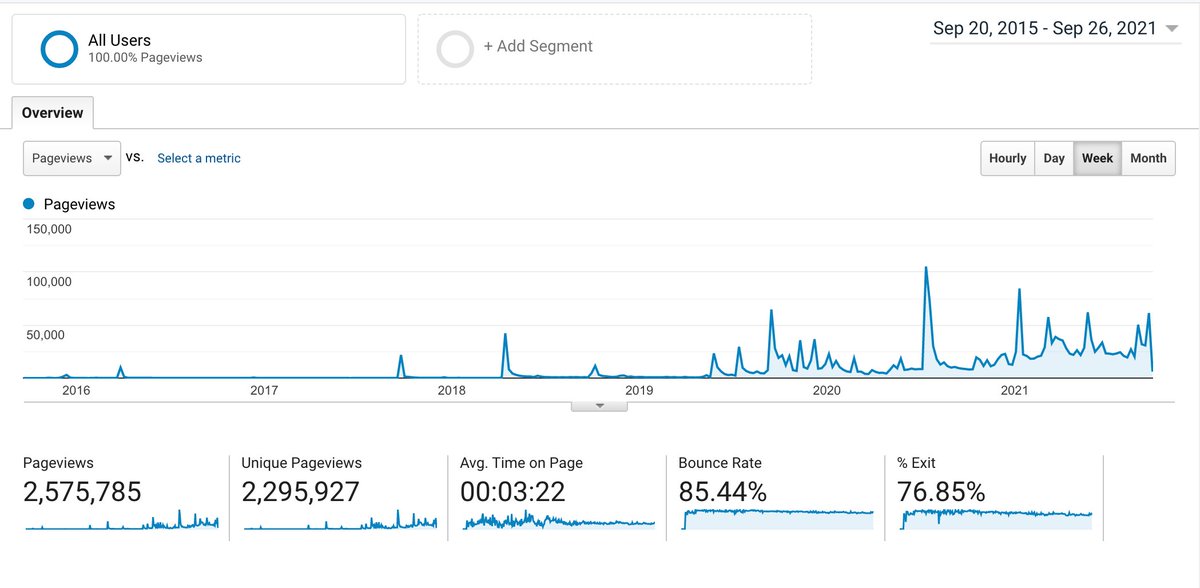
A month into a paid newsletter for eng managers/engineers, it's taking off faster than I ever hoped:
~ 500 paid subscribers (thank you!)
~ 15,000 free subscribers
~ $62K ARR
- A top 10 @SubstackInc technology newsletter
Here's what I learned and advice on writing/newsletters 👇
~ 500 paid subscribers (thank you!)
~ 15,000 free subscribers
~ $62K ARR
- A top 10 @SubstackInc technology newsletter
Here's what I learned and advice on writing/newsletters 👇

1. Start writing. I started The Pragmatic Engineer blog years ago. At first, no one noticed. 70 essays later, a lot of people do.
If I started today, I'd join a community for feedback/encouragement like @bloggingfordevs by @monicalent (a community I'm a paying member of).
If I started today, I'd join a community for feedback/encouragement like @bloggingfordevs by @monicalent (a community I'm a paying member of).

2. Write what *you* want to read. I always liked articles that shared observations on where tech is heading or explained important things with plain language.
So I wrote about this. Like equity in tech blog.pragmaticengineer.com/equity-for-sof… or product-minded engineers blog.pragmaticengineer.com/the-product-mi…
So I wrote about this. Like equity in tech blog.pragmaticengineer.com/equity-for-sof… or product-minded engineers blog.pragmaticengineer.com/the-product-mi…
3. Once people pay attention, offer to capture emails. I did not do this until two years ago.
In those two years, 9,000 people shared emails and in return, I sent a summary of interesting things I've been thinking about in tech. A "best of" digest: docs.google.com/document/d/1i-…
In those two years, 9,000 people shared emails and in return, I sent a summary of interesting things I've been thinking about in tech. A "best of" digest: docs.google.com/document/d/1i-…

4. Write more regularly. My biggest fear of starting a weekly newsletter: can I write every week?
Everyone tackles this fear differently: some just dive in. I wrote regularly the past 12 months, which gave me confidence that I can do this. What I wrote: blog.pragmaticengineer.com/books/
Everyone tackles this fear differently: some just dive in. I wrote regularly the past 12 months, which gave me confidence that I can do this. What I wrote: blog.pragmaticengineer.com/books/
5. Come up with a value proposition.
When I became an eng manager at Uber, my manager offered I could expense whatever publication I wanted, to grow professionally.
I did not find anything for engineering managers or tech leads. So I am writing it: newsletter.pragmaticengineer.com
When I became an eng manager at Uber, my manager offered I could expense whatever publication I wanted, to grow professionally.
I did not find anything for engineering managers or tech leads. So I am writing it: newsletter.pragmaticengineer.com
6. Consider lead generation. While @SubstackInc is a great platform to start a (paid) newsletter, assume you will get little to no traffic from there.
Remember about writing a blog for years? Turns out I have a *lot* of traffic from there. This much: blog.pragmaticengineer.com/stats/
Remember about writing a blog for years? Turns out I have a *lot* of traffic from there. This much: blog.pragmaticengineer.com/stats/

7. Give, give, give. Help, help, help.
Only then ask.
On the day announced I'm starting a $15/month newsletter, 20 people signed up. Before the first issue, this was close to 100.
Most of these people were ones I somehow helped in the past with one of my many articles.
Only then ask.
On the day announced I'm starting a $15/month newsletter, 20 people signed up. Before the first issue, this was close to 100.
Most of these people were ones I somehow helped in the past with one of my many articles.
8. Nothing beats regular original, and high quality.
I've noticed there is no shortage of people with original thoughts, and those who can write with high quality.
Almost no one does this regularly. Not in engineering, not in other niches.
If you can do this: you'll get ahead.
I've noticed there is no shortage of people with original thoughts, and those who can write with high quality.
Almost no one does this regularly. Not in engineering, not in other niches.
If you can do this: you'll get ahead.
9. Set a schedule.
If you write a weekly newsletter, come up with a schedule. For every article, I need to account for:
- Idea
- Research
- Draft
- Reviews
- Editing
This can take up more than a week. So I have a few of these run parallel.
If you write a weekly newsletter, come up with a schedule. For every article, I need to account for:
- Idea
- Research
- Draft
- Reviews
- Editing
This can take up more than a week. So I have a few of these run parallel.
10. Twitter is underrated for tech professionals.
I connected with amazing people in the tech community, and - just as importantly - regularly get inspiration, information, and feedback from people.
I frequently share drafts of my articles, and Twitter helps make them better.
I connected with amazing people in the tech community, and - just as importantly - regularly get inspiration, information, and feedback from people.
I frequently share drafts of my articles, and Twitter helps make them better.
11. If you're going paid, or want to improve your writing: hire an editor. Once you find someone you click with: stick with them.
My editor is @BestEngCopy and he has made me a better writer, and my writing more pleasant to read. 100% recommend.
My editor is @BestEngCopy and he has made me a better writer, and my writing more pleasant to read. 100% recommend.
https://twitter.com/GergelyOrosz/status/1376516197055934474?s=20
12. Stand on the shoulders of giants. I have @lennysan to thank for the inspiration of starting a newsletter, and his very open sharing of his journey - including how he wondered if he should have gone paid earlier.
And this tweet thread is inspired by:
And this tweet thread is inspired by:
https://mobile.twitter.com/lennysan/status/1265072097849602048
13. Have a goal and stick to it.
I want to make it easy for engineers and managers to grow, week after week, while keeping up with stuff that works in the industry, especially with high-growth places.
Hop onboard here: newsletter.pragmaticengineer.com
I want to make it easy for engineers and managers to grow, week after week, while keeping up with stuff that works in the industry, especially with high-growth places.
Hop onboard here: newsletter.pragmaticengineer.com
14. If you're hesitating: grab the discount (and if you have a learning/training/professional development budget, consider expensing it).
Until 30 September, the newsletter is $100/year as the special launch pricing and increases afterward. newsletter.pragmaticengineer.com/p/coming-soon
Until 30 September, the newsletter is $100/year as the special launch pricing and increases afterward. newsletter.pragmaticengineer.com/p/coming-soon
• • •
Missing some Tweet in this thread? You can try to
force a refresh





